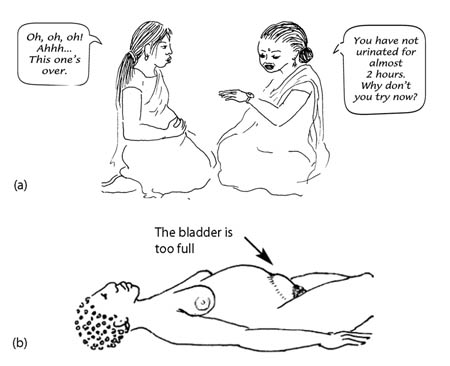3.1.9 Bladder care
Encourage the woman to urinate at least once every 2 hours (Figure 3.5a). If her bladder is full, her contractions may get weaker and her labour longer. A full bladder can also cause pain, problems with pushing out the placenta, and bleeding after childbirth. Remind the mother to urinate – she may not remember.

To check if the bladder is full, feel the mother’s lower belly. A full bladder feels like a plastic bag full of water. When the bladder is very full, you can see the shape of it under the mother’s skin (Figure 3.5b). Do not wait until her bladder gets this big.
If the mother’s bladder is full, she must urinate. If she cannot walk, try putting a pan or extra padding under her bottom and let her urinate where she is. It may help her to begin to urinate if you dip her hand in warm water.
Why do you think a full bladder can interfere with the normal progress of labour? (Think back to what you know from the previous two study sessions.)
During the first and second stage of labour, a full bladder interferes with the normal uterine contraction and inhibits the baby’s head from entering the pelvic brim.
As you will see in Study Session 6, during the third stage of labour it can also delay delivery of the placenta, which increases the risk of post-partum haemorrhage (Study Session 11).
3.1.8 Drinking fluids during labour
